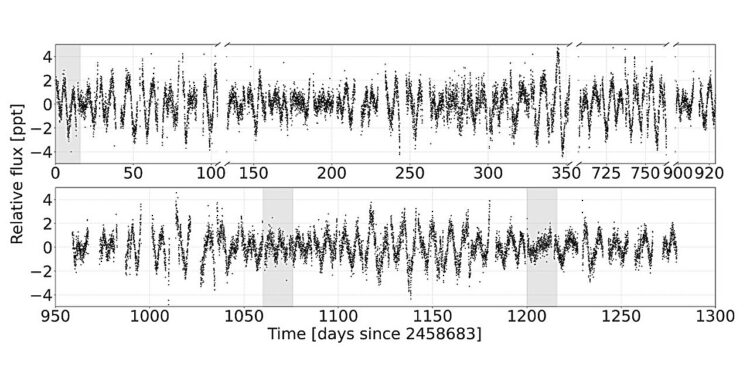The full 120 s SPOC TESS light curve of TOI-1437, rated at 30 min. Credit: Rubenzahl et al, 2024
Thanks to NASA’s Transiting Exoplanet Survey Satellite (TESS), astronomers have detected a new exoplanet at a very short period. The newly discovered alien world is nearly twice the size of Earth and orbits its host star in less than a day. The discovery was reported in a paper published February 12 on the preprint server. arXiv.
To date, TESS has identified more than 7,000 candidate exoplanets (TESS Objects of Interest, or TOI), of which 417 have been confirmed so far. Since its launch in April 2018, the satellite has studied around 200,000 of the brightest stars near the sun in an effort to search for transiting exoplanets, ranging from small rocky worlds to gas giants.
Today, a group of astronomers led by Ryan A. Rubenzahl of the California Institute of Technology (Caltech) confirmed another TOI monitored by TESS. Rubenzahl’s team reports that the transit signal identified in the light curve of a star known as TOI-1347 is planetary in nature.
“We present confirmation and characterization of USP (ultra-short period) TOI-1347 b, a planet of 1.8 ± 0.1 Earth radius in a 0.85 day orbit that was detected with the photometry of the TESS mission,” the researchers wrote in the paper.
As noted in the study, TOI-1437 has a radius of about 1.8 Earth radii and is about 11.1 times more massive than our planet, giving an apparent density of 9.9 g/cm.3. It takes about 20 hours and 20 minutes for the planet to orbit its parent star. Astronomers estimate that TOI-1437 has an equilibrium temperature of about 1,400 K as it orbits its host at a distance of about 4.43 solar radii.
The researchers noted that TOI-1437 most likely has an Earth-like composition and is so far the most massive USP among those with radii less than 2.0 Earth radii. The results also suggest that the planet has a high average molecular weight atmosphere. However, this needs to be further confirmed, for example using the James Webb Space Telescope (JWST).
As for the host star TOI-1437 (also known as TIC 229747848), it is a late G-type star with high variability. It has a radius of approximately 0.83 solar radii, while its mass has been measured at 0.91 solar masses. The star’s age is estimated to be around 1.4 billion years and its effective temperature is 5,464 K.
Besides confirming TOI-1437 b as an exoplanet, Rubenzahl’s team also reports the detection of another smaller planet in the system. The extrasolar world, which received the designation TOI-1437 c, is slightly smaller than TOI-1437 b because it has a radius of approximately 1.6 Earth radii. Since the paper’s authors were unable to identify this planet with radial velocity measurements, they set an upper limit for its mass, at 6.4 Earth masses.
More information:
Ryan A. Rubenzahl et al, The TESS-Keck Survey. XII. A very short-period dense 1.8 R⊕ planet perhaps clinging to a high mean molecular weight atmosphere after the first Gyr, arXiv (2024). DOI: 10.48550/arxiv.2402.07451
Journal information:
arXiv
© 2024 Science X Network
Quote: Discovery of a new very short-period exoplanet (February 20, 2024) retrieved on February 20, 2024 from
This document is subject to copyright. Apart from fair use for private study or research purposes, no part may be reproduced without written permission. The content is provided for information only.



